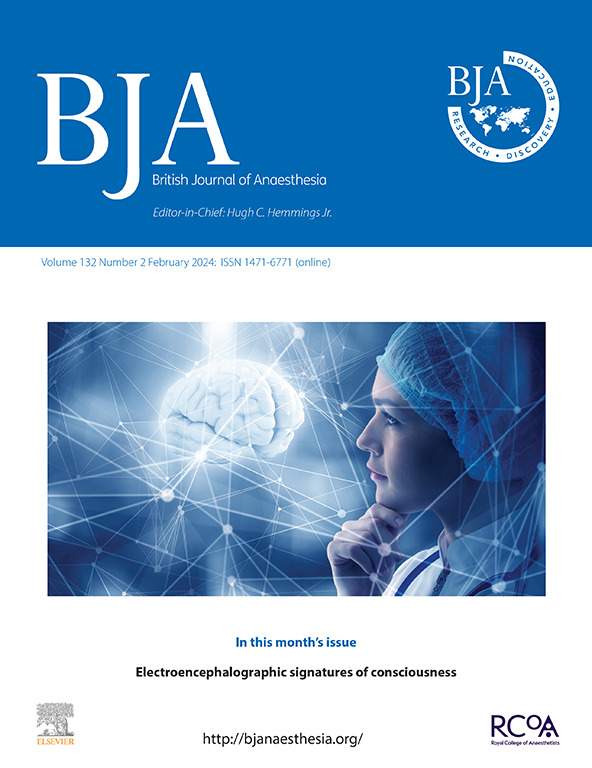Use of smart glasses imaging for interscalene brachial plexus block: a randomised clinical trial
IF 9.2
1区 医学
Q1 ANESTHESIOLOGY
引用次数: 0
Abstract
Background
Smart glasses can provide real-time ultrasonographic images without additional head–eye movement. We investigated whether smart glasses combined with ultrasonography could improve interscalene brachial plexus block (ISB) procedural efficiency.
Methods
This prospective, randomised trial enrolled 151 patients undergoing upper limb surgery requiring interscalene brachial plexus block. Four anaesthesiologists received standardised training in smart glasses-assisted (smart glasses group) or conventional (control group) ultrasound guidance. The primary outcome was total procedure time.
Results
Five participants were excluded, and 146 participants were included in the analysis. The total puncture time was shorter in the smart glasses group compared with the control group (124.0 [98.0–155.5 ] s vs 153.0 [123.0–197.5] s; P<0.001). In addition, the ultrasound probe imaging time was better in the smart glasses group than in the control group (19.0 [13.5–30.0] s vs 31.0 [20.0–51.0 ] s; P<0.001), and the period from the first skin puncture to reaching the target area was also shorter (16.0 [12.5–24.5] s vs 26.0 [18.5–33.5] s; P<0.001). Hand–eye coordination was significantly better in the smart glasses group compared with the control group, which included fewer operator head movements (1.0 [1.0–2.0] vs 5.0 [3.0–8.0]; P<0.001); more consistent needle redirections (3.00 [2.0–3.0] vs 3.0 [2.0–4.0]; P=0.004). Pain scores remained similarly low in both groups, with no significant differences in adverse event rates. Ergonomic satisfaction scores (rated 4 or 5) were higher in the smart glasses group (56.2% [41/73] vs 24.7% [18/73]; P<0.001).
Conclusions
Smart glasses reduced the procedure time for experienced anaesthetists performing interscalene brachial plexus block compared with the control group, and improved their hand–eye coordination and satisfaction.
Clinical trial registration
Chinese Clinical Trial Registry (ChiCTR2400091595).
使用智能眼镜成像斜角间臂丛神经阻滞:一项随机临床试验。
智能眼镜可以提供实时超声图像,而无需额外的头眼运动。我们研究了智能眼镜联合超声检查是否能提高斜角间臂丛阻滞(ISB)的手术效率。方法:本前瞻性随机试验纳入151例接受上肢手术需要斜角肌间臂丛阻滞的患者。4名麻醉师接受了智能眼镜辅助(智能眼镜组)或常规(对照组)超声引导的标准化培训。主要观察指标为手术总时间。结果排除5名受试者,共纳入146名受试者。智能眼镜组总穿刺时间较对照组短(124.0 [98.0-155.5]s vs 153.0 [123.0-197.5] s);P < 0.001)。此外,智能眼镜组超声探头成像时间优于对照组(19.0 [13.5-30.0]s vs 31.0 [20.0-51.0] s;P<0.001),从第一次皮肤穿刺到到达目标区域的时间也更短(16.0 [12.5-24.5]s vs 26.0 [18.5-33.5] s;P < 0.001)。与对照组相比,智能眼镜组的手眼协调能力明显更好,其中包括更少的操作员头部运动(1.0 [1.0-2.0]vs 5.0 [3.0-8.0]);P < 0.001);更一致的针重定向(3.00 [2.0-3.0]vs 3.0 [2.0-4.0];P = 0.004)。两组患者的疼痛评分相似地保持在较低水平,不良事件发生率无显著差异。智能眼镜组的人体工程学满意度得分(4或5分)更高(56.2% [41/73]vs 24.7% [18/73]);P < 0.001)。结论与对照组相比,智能眼镜减少了经验丰富的麻醉师进行斜角间臂丛神经阻滞的手术时间,提高了他们的手眼协调能力和满意度。中国临床试验注册中心(ChiCTR2400091595)。
本文章由计算机程序翻译,如有差异,请以英文原文为准。
求助全文
约1分钟内获得全文
求助全文
来源期刊
CiteScore
13.50
自引率
7.10%
发文量
488
审稿时长
27 days
期刊介绍:
The British Journal of Anaesthesia (BJA) is a prestigious publication that covers a wide range of topics in anaesthesia, critical care medicine, pain medicine, and perioperative medicine. It aims to disseminate high-impact original research, spanning fundamental, translational, and clinical sciences, as well as clinical practice, technology, education, and training. Additionally, the journal features review articles, notable case reports, correspondence, and special articles that appeal to a broader audience.
The BJA is proudly associated with The Royal College of Anaesthetists, The College of Anaesthesiologists of Ireland, and The Hong Kong College of Anaesthesiologists. This partnership provides members of these esteemed institutions with access to not only the BJA but also its sister publication, BJA Education. It is essential to note that both journals maintain their editorial independence.
Overall, the BJA offers a diverse and comprehensive platform for anaesthetists, critical care physicians, pain specialists, and perioperative medicine practitioners to contribute and stay updated with the latest advancements in their respective fields.

 求助内容:
求助内容: 应助结果提醒方式:
应助结果提醒方式:


